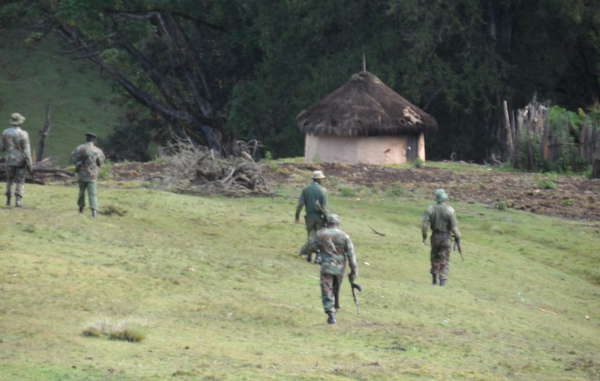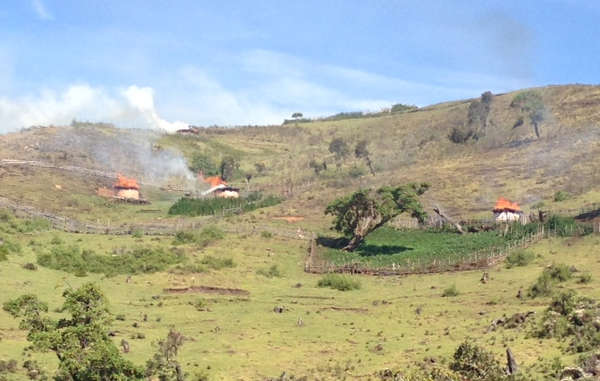January 31, 2014
Last year the Government of Kenya was getting “ready” for REDD in the Embobut Forest, now it is violently evicting the Sengwer People and forcing them “into extinction.” According to Survival International, “as many as a thousand homes have already been torched.”[i]
Sengwer spokesman Yator Kiptum denounced the “disaster” caused by combined force of the Kenya Forest Service and Administration Police, a paramilitary unit of the police, which is now evicting the Sengwer not just from the Embobut Forest but from the entirety of the Cherangany Hills, destroying property and burning homes. “The government of Kenya is forcing us into extinction,” he said.[ii]
The extension of the evictions to all other areas in the Cherangany Hills forest complex to include Kapolet and Lelan/Kamolokon “means the removal of the entire population of Sengwer indigenous people living in the Cherangany Hills from their ancestral lands.”[iii] Some13,500 Sengwer live in the Cherangany Hills in Kenya’s Northern Rift Valley, and are one of the few hunter-gatherer groups left in eastern Africa.[iv]
According to Forest Peoples Programme, the Sengwer are not squatters. “The Sengwer have their rights to their ancestral forest lands enshrined in the Constitution and international law.” [v] The Sengwer obtained court orders to prevent further evictions to no avail.
Inspector Stephene Chessa who works for the Kenya Forest Service and is in charge of the Embobut evictions, denied anyone had been evicted by force. According to Mr. Chessa, the presence of the security forces is to ensure that the process is smooth.[vi] Funders of the Kenya Forest Service include the World Bank and the government of Finland.[vii]
Forest guards arrive in Kenya’s Embobut Forest in preparation for the evictions. © FPP
Last year, the World Bank funded the Government of Kenya’s REDD+ Program exclusively through its $68.5 million dollar Natural Resources Management Program, in the Cherangany Hills.[viii]
According its Inspection Panel report No. 77959-KE, the World Bank was “financing REDD+ readiness activities” as part of this program. As of last May, activities started include: “Identification of Grazing Systems as a REDD+ Strategy Option [and] Development of a Methodology for Monitoring Community Engagement in Forest Management and REDD+.”[ix] REDD (Reducing Emissions from Deforestation and Degradation) is a carbon offset mechanism that uses forests and land as sponges for Northern pollution.[x]
Solomon Mibei, Head of Conservation at Kenya Forest Service (KFS), said that “At the moment, the KFS is conducting workshops with communities living around the Embobut forest and the Kakamega forest to educate them on carbon financing.”[xi]
Homes of the Sengwer People in Kenya’s Cherangany Hills torched by forest guards © Justin Kenrick/ Survival
However, according to Forest Peoples Programme, KFS does not have a good track record protecting forests. “…when the KFS is in control then indigenous forest is fast destroyed, as profit-making plantations and agriculture replace the biodiversity of the indigenous forest.”[xii]
Possible partners for eventually doing REDD in Kenya include the Africa Development Bank, which is already working with communities on “forest conservation” exchange programs through a programme known as Green Zones Development Support Project (GZDSP).[xiii] Toyota[xiv] and Coca-Cola[xv] may also be prospective partners.
Last year, Sengwer representatives denounced previous KFS evictions in 2007, 2008, 2009, 2010 and 2011 as well as the alleged shooting of the Sengwer woman Mrs. Beatrice Chepkorir in The Cherangany Hills Project Operation area of the World Bank-funded Natural Resources Management Project.[xvi] The Sengwer representatives also demanded that the Bank suspend funding for REDD+ until these injustices are addressed.[xvii]
This is not the first time in Kenya that Indigenous People suffer violent evictions from their ancestral territory that is slated for REDD. “The Mau Forest was made “ready” for UNEP-funded REDD with violent evictions of the Indigenous Ogiek People,” which threaten their cultural survival.[xviii] A landmark ruling on these evictions is expected to be handed down by the African Court this year.
The evictions of the Sengwer join the growing roster of land grabs and grave human rights violations caused by REDD ‘readyness” initiatives and forest carbon projects, which also include persecution, imprisonment, and killing.[xix] The evictions of the Sengwer may also confirm Friends of the Earth International’s concern that REDD could “foster an ‘armed protection’ mentality that could lead to the displacement of millions of forest-dependent people, including by force.”[xx]
“A false solution to climate change, REDD+ is emerging as a new form of colonialism, economic subjugation and a driver of land grabs so massive that they may constitute a continent grab. We must defend the continent from carbon colonialism,” declares the No REDD in Africa Network.
Even the United Nations admits that REDD+ could result in the “lock-up of forests,” “loss of land,” “conflict over resources,” “new risks for the poor” and “marginalize the landless.”[xxi]
There has been some debate as to whether REDD could potentially cause cultural genocide.[xxii] The evictions of the Sengwer People indicate that it very well may.
###
[i] Kenyan government forcing us into extinction’: evictions of Sengwer tribe escalate , Survival International, 24 January 2014 http://www.survivalinternational.org/news/9932
[ii] Ibid.[iii] Kenya Burns Indigenous People Out of Ancestral Lands, Environmental News Service, January 22, 2014 http://ens-newswire.com/2014/01/22/kenya-burns-indigenous-people-out-of-ancestral-lands/
[iv] Sengwer, Marakwet and other inhabitants of the Embobut Forest are being told to move by authorities, Survival International, March 2013. http://www.survivalinternational.org/news.rss
[v] Ibid. and Indigenous Peoples evicted and their homes set on fire; Embobut forest, Kenya, REDD Monitorhttp://www.redd-monitor.org/2014/01/24/indigenous-peoples-evicted-and-their-homes-set-on-fire-embobut-forest-kenya/#more-14794
[vi] Interview with Inspector Stephen Chessa, by Kenyan journalist Isaiah Esipisu. January 19, 2014.
[vii] Miti Mingi Maisha Bora (MMMB) – Support to the Forest Sector Reform in Kenya, Embassy of Finland in Kenya, “…while components 2 and 3 are primarily implemented by KFS;” Note promotion of “trade in bio-energy.” http://www.finland.or.ke/public/default.aspx?nodeid=46392&contentlan=2&culture=en-US
[viii] PROJECT APPRAISAL DOCUMENT ON A PROPOSED CREDIT IN THE AMOUNT OF SDR 46.0 MILLION (US$68.5 MILLION EQUIVALENT) TO THE GOVERNMENT OF KENYA FOR A NATURAL RESOURCE MANAGEMENT PROJECT February 26, 2007 http://www-wds.worldbank.org/external/default/WDSContentServer/WDSP/IB/2007/03/12/000020953_20070312104941/Rendered/PDF/37982.pdf
[ix] World Bank Inspection Panel, Report and Recommendation KENYA: Natural Resource Management Project (P095050), May 29, 2013, page 70 http://www-wds.worldbank.org/external/default/WDSContentServer/WDSP/IB/2013/05/31/000442464_20130531104013/Rendered/PDF/779590IPR0P09500lPN0REQUEST0RQ01302.pdf
[x] See No REDD Papers, Volume 1 http://www.no-redd.com/ No REDD Reader, http://noredd.makenoise.org/wp-content/uploads/2010/REDDreaderEN.pdf
[xi] Interview with Solomon Mibei Head of Conservation Kenya Forest Services by Kenyan journalist Isaiah Esipisu, January 18, 2014.
[xii] Kenya Burns Indigenous People Out of Ancestral Lands http://ens-newswire.com/2014/01/22/kenya-burns-indigenous-people-out-of-ancestral-lands/
[xiii] Interview with Solomon Mibei Head of Conservation Kenya Forest Services by Kenyan journalist Isaiah Esipisu, January 18, 2014.
[xiv] Interview with Sayoko Morita, Assistant to Managing Director, and in charge of the Cooperate Social Responsibility – Toyota Kenya by Kenyan journalist Isaiah Esipisu,, January 2014;
Cherangany water tower gets new lease on life, The Standard, 11 may 2011, “We presented a proposal to Toyota and they agreed to fund part of the rehabilitation of this important water tower,” said Core Country Chairman Kiyoshi Kita.” https://www.standardmedia.co.ke/?articleID=2000034623&pageNo=1
[xv] Introduction to PES and REDD, Nairobi, 2011, Coca Cola listed as a funder (slide 6): http://www.slideshare.net/ICRAF_PRESA/introduction-ot-pes-and-redd-namirembe “Kerio Valley Development Authority, Eldoret Water and Sanitation Company (Eldowas), Marakwet County Council and Coca Cola have also come together to save the forest.” The Standard, https://www.standardmedia.co.ke/?articleID=2000034623&pageNo=1
[xvi] “Shooting of a woman in Kapolet forest – in 2009 when the forest guards entered Kapolet forest to arrest members of Sengwer families they used live bullets. During the shootings, Mrs. Beatrice Chepkorir a Sengwer indigenous woman was shot from the back and left for death.” page 28 REQUEST FOR INSPECTION PANEL REVIEW OF THE KENYA: NATURAL RESOURCE MANAGEMENT PROJECT (P095050) received by the Inspection Panel on January 14, 2013 and registered on January 30, 2013 (RQ13/02).(Annex 1) http://www-wds.worldbank.org/external/default/WDSContentServer/WDSP/IB/2013/05/31/000442464_20130531104013/Rendered/PDF/779590IPR0P09500lPN0REQUEST0RQ01302.pdf
World Bank The Inspection Panel http://web.worldbank.org/WBSITE/EXTERNAL/EXTINSPECTIONPANEL/0,,contentMDK:23350855~pagePK:64129751~piPK:64128378~theSitePK:380794,00.html
[xvii] Ibid, page 30.
[xviii] The Worse REDD-type Projects in Africa: Continent Grab for Carbon Colonialism , No REDD in Africa Network, http://no-redd-africa.org/index.php/16-redd-players/84-the-worst-redd-type-projects-in-africa-continent-grab-for-carbon-colonialism
[xix] Ibid and A Dozen of the Worst REDD-type Projects, Carbon Trade Watch, http://www.ienearth.org/docs/REDD-A%20Dozen-of-the-Worst-REDD-type-projects.pdf
[xx] Friends of the Earth International, REDD: Critical questions and myths exposed,, Summary www.foei.org/publications
[xxi] UN-REDD Framework Document, http://www.undp.org/mdtf/UN-REDD/docs/Annex-A-Framework-Docoment.pdf , p. 4-5 A Poverty Environment Partnership (PEP) Policy Brief, Based on the report “Making REDD Work for the Poor”, (Peskett et al, 2008) http://www.povertyenvironment.net/pep/ PEP includes UNDP, UNEP, IUCN, OCI, SIDA, ADB, DFID, WCMC
[xxii] Launch of No REDD in Africa Network: “REDD could cause genocide.”
“In 1948, the United Nations approved the Convention on the Prevention and Punishment of the Crime of Genocide, which defines genocide as follows: ‘genocide means any of the following acts committed with intent to destroy, in whole or in part, a national, ethnical, racial or religious group, as such:
(a) Killing members of the group;
(b) Causing serious bodily or mental harm to members of the group;
(c) Deliberately inflicting on the group conditions of life calculated to bring about its physical destruction in whole or in part;
(d) Imposing measures intended to prevent births within the group;
(e) Forcibly transferring children of the group to another group.’
Does this definition apply to REDD? Potentially, it does. REDD could involve a vast area of land (theoretically covering the area of forest land – including large areas of agricultural land – in the global south). The rights to the use of that land could be taken away from Indigenous Peoples who depend on their forests for their livelihoods. Destroying livelihoods on this scale could conform to the parts (a), (b), and (c) of the definition of genocide, above.”
REDD Monitor http://www.redd-monitor.org/2013/04/03/launch-of-no-redd-in-africa-network-redd-could-cause-genocide/
Without a doubt, the massive evictions and burning of their homes are causing the Sengwer People mental harm, and, thus, conforming to criteria (b) of genocide.
Kenya prepara para REDD en el bosque Embobut Forest y
fuerza al pueblo Sengwer “a la extinción”
31 Enero 2014
El año pasado, el Gobierno de Kenya estaba “preparándose” para REDD en el Bosque Embobut, ahora está desalojando violentamente al Pueblo Sengwer y forzándoles “a la extinción.” Según la ONG Survival International, “nada menos que un millar de casas ya han sido incendiadas”.
El portavoz Sengwer, Yator Kiptum, denunció el “desastre” causado por la fuerza combinada del Servicio Forestal de Kenia y de la Administración de Policía, una unidad paramilitar de la policía, que ahora está desalojando la población Sengwer no sólo desde el Bosque Embobut sino de la totalidad de las Lomas de Cherangany, destruyendo sus propiedades y quemando casas “El gobierno de Kenia nos está forzando a la extinción,” ha dicho.
La extensión de los desalojos a todas las otras áreas en el complejo forestal Lomas de Cherangany incluyendo a Kapolet y Lelan/Kamolokon significa la eliminación de toda la población del Pueblo Indígena Sengwer que viven en las Lomas de Cherangany desde sus ancestros. “Alrededor de 13,500 Sengwer viven en las Lomas de Cherangany al norte del Valle Rift de Kenia, y son uno de los pocos grupos de cazadores-recolectores que quedan en el este de África.
De acuerdo con el Programa Forest Peoples, los Sengwer no son colonos ilegales. “El poblado Sengwer tienen sus derechos a sus tierras y bosques ancestrales consagrados en la Constitución y el derecho internacional.” Los Sengwer obtuvieron órdenes judiciales para evitar más desalojos pero ha sido en vano.
El Inspector Stephene Chessa que trabaja para el Servicio Forestal de Kenia y está a cargo de los desalojos del Bosque Embobut, negó que nadie haya sido desalojado por la fuerza. Según el Sr. Chessa, la presencia de las fuerzas de seguridad es para asegurar que el proceso sea tranquilo”. Los financiadores del Servicio Forestal de Kenia incluyen el Banco Mundial y el gobierno de Finlandia.
Guardias forestales llegan al bosque Embobut para preparar los desalojos. © FPP
El año pasado, el Banco Mundial financió al Gobierno de Kenia con el Programa REDD+ de Kenia exclusivamente a través de sus 68.5 millones de dólares del Proyecto de los Recursos Naturales de Gestión, en las Lomas de Cherangany.
Según el informe del Panel de Inspección N º 77959-KE, el Banco Mundial estaba financiando REDD+ “actividades de preparación”. A partir del pasado mes de mayo, las actividades iniciadas incluyen: “Identificación de sistemas de pastoreo como una opción de estrategia REDD+ [y] Desarrollo de una Metodología para el Monitoreo de Participación de la Comunidad en la Gestión Forestal y REDD+.” REDD (Reducción de Emisiones provenientes de Deforestación y Degradación) es un mecanismo de carbono que utiliza los bosques y las tierras como esponjas para la contaminación de los países del norte.
Solomón Mibei, Jefe de Conservación en el Servicio Forestal de Kenia (KFS), dijo que “Por el momento, el KFS está llevando a cabo talleres con las comunidades que viven alrededor del bosque Embobut y el bosque Kakamega para educarles sobre la financiación del carbono.”
Casas del pueblo Sengwer People en Las Lomas de Cherangany de Kenia quemadas por los guardabosques. © Justin Kenrick
Sin embargo, de acuerdo con el Programa Forest Peoples, KFS no tiene un buen historial de protección de los bosques. “…Cuando el KFS está en el control, el bosque nativo se destruye rápidamente, ya que las plantaciones con fines de lucro y la agricultura reemplazan la biodiversidad del bosque nativo.”
Los posibles socios para hacer REDD en Kenia incluyen el Banco de Desarrollo de África, que ya está trabajando con las comunidades en los programas de intercambio de “conservación de bosques ” a través de un programa conocido como Proyecto de Apoyo a Espacios Verdes (GZDSP). Toyota y Coca-Cola también pueden ser posibles socios.
El año pasado, los representantes Sengwer denunciaron desalojos previos por KFS en 2007, 2008, 2009, 2010 y 2011, así como el presunto asesinato de la mujer de la mujer Sengwer Beatrice Chepkorir en el área de las Lomas de Cherangany del Proyecto de Manejo de Recursos Naturales, financiado por el Banco Mundial. Los representantes Sengwer también exigieron que el Banco suspenda la financiación de REDD+ hasta que estas injusticias sean resueltas.
Esta no es la primera vez en Kenia que los pueblos indígenas sufren desalojos violentos de su territorio ancestral que está programado para REDD. “El bosque Mau ya fue “preparado” para REDD financiado por PNUMA con violentos desalojos del Pueblo Indígena Ogiek, los cuales amenazan su supervivencia cultural. Se espera un fallo histórico sobre los desalojos que se dicte por el Tribunal Africano de este año.
Los desalojos de los Sengwer se unen a la creciente lista de los despojos de tierras y las graves violaciones de los derechos humanos causadas por las iniciativas de REDD, la preparación para REDD y los proyectos de carbono forestal. Tales violaciones incluyen la persecución, el encarcelamiento y asesinatos. Los desalojos de los Sengwer también pueden confirmar la preocupación de Amigos de la Tierra Internacional que REDD puede causar “el desplazamiento de millones de personas que dependen de los bosques, incluso por la fuerza.”
“Una falsa solución al cambio climático, REDD+ está emergiendo como una nueva forma de colonialismo, subyugación económica e impulsa despojo de tierra tan masivo que puede constituir un despojo de todo el continente africano. Debemos defender el continente del colonialismo del carbono”, declara la Red contra REDD en África.
Incluso las Naciones Unidas reconoce que REDD+ podría resultar en la “clausura de los bosques”, “pérdida de la tierra”, “conflictos por los recursos”, “nuevos riesgos para los pobres” y “marginar a los sin tierra.”
Ha habido un debate sobre si REDD podría potencialmente causar genocidio cultural. Los desalojos del Pueblo Sengwer indican que sin duda REDD puede causar genocidio.
###
Red contra REDD en África http://no-redd-africa.org/ Comuníquese: noreddinafrica@gmail.com



